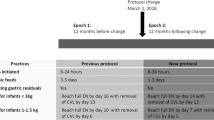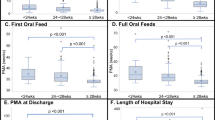Abstract
The ever-increasing survival of premature and extremely low birth weight infants has posed a great challenge to neonatologists and nutritionists. While nutrient requirements are still being defined, there is a great need to continue to improve our strategies for providing effective nutrition for these infants. Similarly, postdischarge nutritional issues need to be addressed since catch-up growth does not always occur. In addition to fetal origins of adult diseases, especially cardiovascular disorders, diabetes and obesity, new data are emerging that postnatal growth alterations also affect these same disorders. However, as we learn more about the latter issues, one needs to be cautious about abandoning our current practices in providing optimal nutrition.
This is a preview of subscription content, access via your institution
Access options
Subscribe to this journal
Receive 12 print issues and online access
$259.00 per year
only $21.58 per issue
Buy this article
- Purchase on Springer Link
- Instant access to full article PDF
Prices may be subject to local taxes which are calculated during checkout
Similar content being viewed by others
References
Martin JA, Hamilton BE, Sutton PD, Ventura SJ, Mecacker F, Munson ML . Births: final data for 2002. Natl Vital Stat Rep 2003;52(10):1–113.
Nutritional needs of the preterm infant In: Pediatric Nutrition Handbook. 5th ed. American Academy of Pediatrics; 2004.
Dobbing J . Nutritional growth restriction and the nervous system In: Davison AN, Thompson RHS, editors. The Molecular Basis of Neuropathology. London: Edward Arnold; 1981. p. 221–233.
Barker DJ . Fetal origins of cardiovascular disease. Ann Med 1999;31(Suppl 1):3–6.
Barker DJ, Gluckman PD, Godfrey KM, Harding JE, Owens JA, Robinson JS . Fetal nutrition and cardiovascular disease in adult life. Arch Dis Child 1993;341:938.
Fall CH, Vijayakumar M, Barker DJ, Osmond C, Duggleby S . Weight in infancy and prevalence of coronary heart disease in adult life. BMJ 1995;310:17–19.
Ehrenkranz RA, Younes N, Lemons JA, Fanaroff AA, Donovan EF, Wright LL . Longitudinal growth of hospitalized very low birth weight infants. Pediatrics 1999;104:280–289.
Alexander GR, Himes JH, Kaufman RB, Mor J, Kogan M . A United States national reference for fetal growth. Obstet Gynecol 1996;87:163–168.
Embleton NE, Pang N, Cooke RJ . Postnatal malnutrition and growth retardation: an inevitable consequence of current recommendations in preterm infants? Pediatrics 2001;107:270–273.
Kashyap S, Schulze KF, Ramakrishnan R, Dell RB, Heird WC . Evaluation of a mathematical model for predicting the relationship between protein and energy intakes of low-birth-weight infants and the rate and composition of weight gain. Pediatr Res 1994;35:704.
Bhatia J, Rassin DK . Growth and total body water in premature infants fed “in-utero” or “ex-utero”. Acta Paediatr Scand 1988;77:326–331.
Lucas A, King F, Bishop NB . Postdischarge formula consumption in infants born preterm. Arch Dis Child 1992;67:691–692.
Lucas A, Fewtrell MS, Morley R, Singhal A, Abbott RA, Isaacs E . Randomized trial of nutrient-enriched formula versus standard formula for post discharge preterm infants. Pediatrics 2001;107:683–689.
Cooke RJ, Griffin IJ, McCormick K, Wells JC, Smith JS, Robinson SJ . Feeding preterm infants after hospital discharge: effect of dietary manipulation on nutrient intake and growth. Pediatr Res 1998;43:355–360.
Ehrenkranz RA, Younes N, Lemons JA, Fanaroff AA, Donovan EF, Wright LL . Longitudinal growth of hospitalized very low birth weight infants. Pediatrics 1999;104:280–289.
Ernst KD, Radmacher PG, Rafail RD, Adamkin DH . Postnatal malnutrition of extremely low birth-weight infants with catch-up growth postdischarge. J Perinatol 2003;23:483–488.
Johnson DB, Cheney C, Monsen ER . Nutrition and feeding in infants with bronchopulmonary dysplasia after initial hospital discharge: risk factors for growth failure. J Am Diet Assoc 1998;98:649–656.
Fewtrell MS, Doherty C, Cole TJ, Stafford M, Hales CN, Lucas A . Effects of size at birth, gestational age and early growth in preterm infants on glucose and insulin concentrations at 9–12 years. Diabetologia 2000;43:714–717.
Singhal A, Lucas A . Early origins of cardiovascular disease: is there a unifying hypothesis? Lancet 2004;363:1642.
Ziegler EE, O'Donnell AM, Nelson SE, Fomon SJ . Body composition of the reference fetus. Growth 1976;40:329.
Author information
Authors and Affiliations
Additional information
Disclosure: Research Support from Diametrics Medical Inc., Discovery Laboratories, Mead Johnson Nutritionals and Consultant: DEY, L.P., Forest Pharmaceuticals, Mead Johnson Nutritionals, Ross Labs.
Rights and permissions
About this article
Cite this article
Bhatia, J. Post-Discharge Nutrition of Preterm Infants. J Perinatol 25 (Suppl 2), S15–S16 (2005). https://doi.org/10.1038/sj.jp.7211311
Published:
Issue Date:
DOI: https://doi.org/10.1038/sj.jp.7211311



